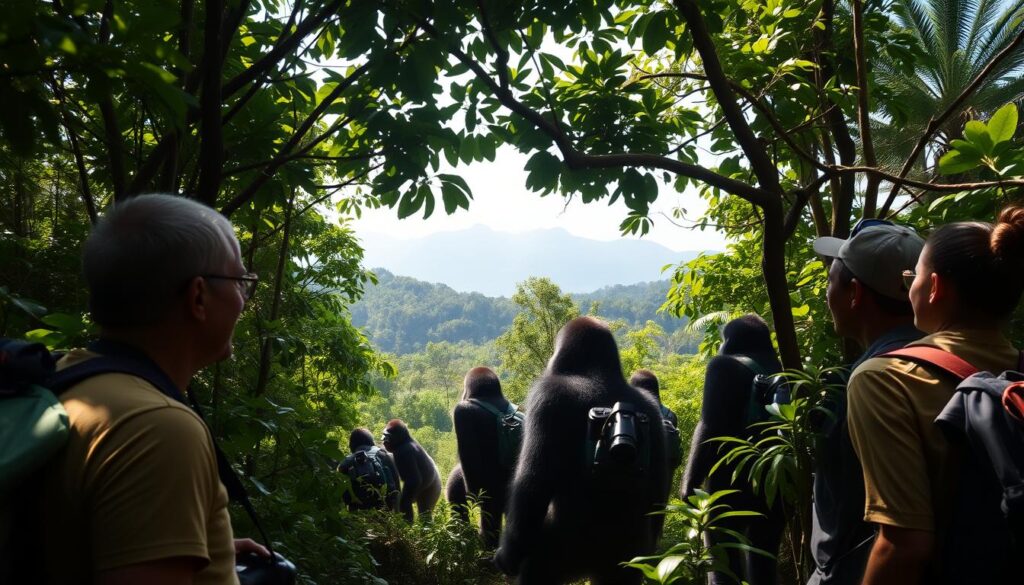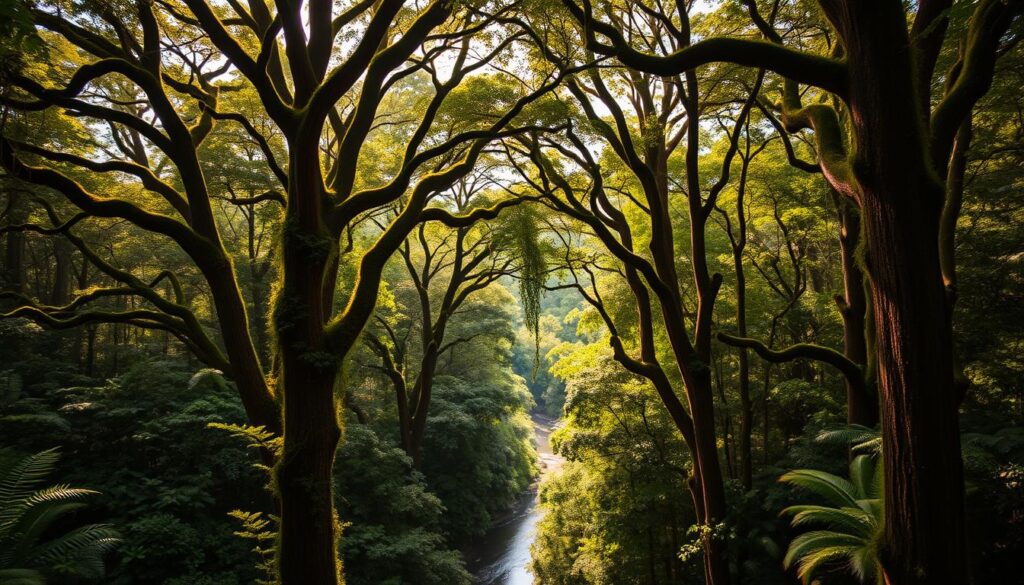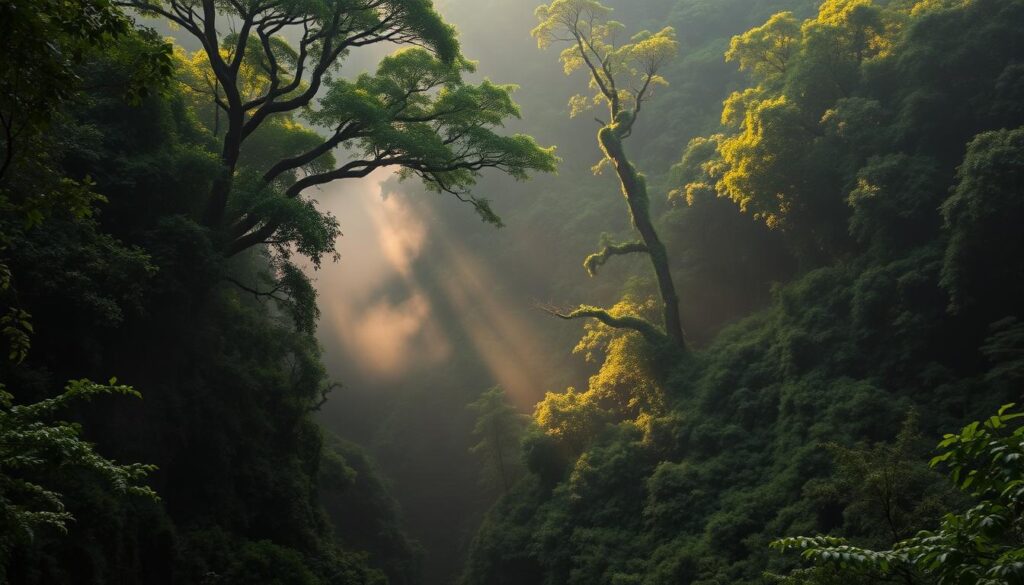Nearly half of the world’s mountain gorillas live inside this compact national park — a startling fact that shows the park’s global value and rare wildlife.
Your introduction here will explain the origin of the name, where the park sits in the Albertine Rift, and why steep ridges and misty valleys shape every trek.
The name grew from thick vines, bamboo and ferns that early visitors called a place full of darkness. That dense growth gave the area its reputation as an impenetrable forest and kept its wildlife safe for generations.
You’ll meet mountain gorillas, learn quick logistics for U.S. travelers — permits, seasons and access — and glimpse how local conservation turned a fragile home into a world-famous success.
Expect muddy trails, earned sightings and meaningful community benefits. This section sets the stage for planning a safe, low-impact adventure that rewards curiosity.
Key Takeaways
- This park shelters nearly half the world’s mountain gorillas.
- The name comes from dense growth and shadowed valleys that felt impenetrable to early visitors.
- Location: Albertine Rift, near the Virunga massif and the DRC border.
- Practical preview: permits, best seasons, access routes for U.S. travelers.
- Conservation here links your visit to real benefits for wildlife and communities.
Why is Bwindi called impenetrable forest? Origins, setting, and UNESCO status
Your first clue comes from Runyakitara. The older name, “Mubwindi,” means a place of deep shadow. That word points to tight bamboo stands, climbing vines and thick undergrowth that made travel slow and dark.
The park sits on the Albertine Rift escarpments in southwest Uganda, adjacent to the Democratic Republic Congo border and within view of the Virunga mountains about 25 km away. Covering roughly 331 km², elevations range from about 1,160 to 2,607 m, giving fast-changing habitats and a wealth of tree species and ferns.
Declared a national park in 1991 and a world heritage site in 1993, this protected area became a conservation stronghold. It holds nearly half the global mountain gorilla population and hundreds of other species in a compact park.
What “impenetrable” means on the trail
On the ground, the impenetrable forest label translates to steep, muddy slopes, dense trees and tangled vines. Expect slow, sweaty treks over roots and clay—conditions that demand fitness, patience and respect for the habitat.
- Decode the name: “Mubwindi” evolved into the modern name describing terrain once nearly impassable on foot.
- Map context: The park’s location on the albertine rift explains its rare climate and species mix.
- Protected status: UNESCO listing and national designation secure vital habitat for gorillas and highland biodiversity.
Biodiversity, gorilla trekking, and planning your trip to Bwindi Impenetrable National Park

Every sector here holds its own cast of gorilla families, birds, and rare mammals waiting on narrow trails. The park shelters nearly half the world’s mountain gorillas and more than 120 other mammals. Your trek may reveal chimpanzees calling, monkeys flashing through the canopy, or a duiker slipping into the undergrowth.
Wildlife and habitats:
The park contains four vegetation belts: lowland, montane, bamboo, and sub-alpine. Over 400 plant species include about 200 tree species and 100+ ferns. These layers create homes for mountain gorillas, leopard-like golden cats, forest elephants, and a rich mix of primates.
Birding and Mubwindi Swamp:
Ruhija’s Mubwindi Swamp is a highlight for bird species spotting. With roughly 350 birds recorded, you might see endemics such as the African green broadbill on misty ridgelines.
Choose your sector:
Buhoma for classic trails and history. Ruhija for birding. Rushaga for many gorilla families and habituation options. Nkuringo for steep terrain and big views.
“Tourism fees fund ranger patrols and community projects that keep these mountain gorillas safe.”
When to go, rules, and costs:
Dry months (Jun–Aug, Dec–Feb) give firmer trails. Heavy rains (Mar–May, Sep–Nov) mean mud and slower hikes. Trekking limits: eight visitors per gorilla group for one hour. Sick visitors cannot trek.
| Item | Cost (USD) | Notes |
|---|---|---|
| Gorilla trekking permit | 700 (foreign nonresident) | Book via Uganda Wildlife Authority |
| Permit (foreign resident) | 600 | Requires residency proof |
| Habituation experience | 1,500 | Up to 4 hours with gorilla family |
| Typical extras | 100–300 | Porters, guides, tips, local transfers |
From the U.S., fly into Entebbe, then travel by 4×4 or take a domestic flight to Kihihi for a shorter transfer. Your permit fees support Uganda Wildlife Authority operations and local conservation. Pack gaiters, sturdy boots, and a readiness for steep climbs — the reward is close-up time with a mountain gorilla and memories that matter.
How Bwindi compares and why it matters: conservation gains and community impact

Standards for gorilla destinations vary across the Albertine Rift, and each park offers a distinct rhythm of trails, access, and sightings.
Compare at a glance: Volcanoes (Rwanda) offers shorter drives from Kigali and quicker access. Mgahinga and Virunga sit across the same mountain chain, sharing gorilla families and cross-border conservation work. Yet bwindi impenetrable forest delivers ancient hills, varied sectors, and wilder, steeper treks.
Conservation outcomes and funding
As a world heritage site and heritage site, this conservation area enforces strict rules: eight visitors per group and one-hour encounters. Permit fees fund rangers, monitoring, and Uganda Wildlife Authority operations in the Bwindi-Mgahinga conservation area.
Community engagement and the Batwa people
Local projects share tourism revenue through porter programs, guides, and cultural visits. The batwa people lost land when parks formed; today responsible tourism aims to restore income, preserve knowledge, and support schools and clinics.
- Experience style: Bwindi favors challenging treks and intimate gorilla sightings.
- Protection: Funding channels keep populations and species like primates, monkeys, and bird life secure.
- Travel tip: Choose tours that employ local guides and support Batwa-led initiatives.
“Your visit can strengthen protection and lift local livelihoods across this shared region.”
Conclusion
Walk a ridge at dawn and the tangled slopes soon explain the area’s old reputation. In this bwindi impenetrable forest, vines, mist, and deep shade hide rare species until a single clear moment of reveal.
Your visit matters here. This world heritage national park shelters half world mountain gorillas and dozens of bird species. Gorilla trekking across Buhoma, Ruhija, Rushaga, or Nkuringo gives you close encounters with gorilla families while monkeys and birds color the scene.
Plan carefully: secure permits, hire certified guides and porters, and pack for rain and steep climbs. Small choices make a strong, lasting impact—funding rangers, research, and community projects. Let this impenetrable national place change how you see wild places and your role in protecting them.
FAQ
What does the name Mubwindi mean and where did the term originate?
Mubwindi comes from local Runyankore-Rukiga roots and refers to dense, mist‑shrouded places. Early explorers and colonial records adopted the term to describe the park’s thick, maze‑like vegetation. That descriptive name helped shape the English label used by travellers and conservationists.
Where is the park located and how does it relate to the Albertine Rift and the Democratic Republic of Congo?
The national park lies in southwestern Uganda along the Albertine Rift, a biodiversity hotspot. It borders the Democratic Republic of Congo across a complex landscape of hills and valleys. This location creates ecological links with nearby protected areas and contributes to shared primate populations.
What does the World Heritage Site designation mean for the park?
UNESCO inscription recognizes outstanding universal value — rare biodiversity, globally important mountain gorilla populations, and unique montane forests. The status brings international attention, stricter conservation oversight, and access to technical and funding support for protection and sustainable management.
What makes the park so biodiverse and home to endangered mountain gorillas?
Elevation gradients, varied soil types and high rainfall create multiple habitats from lowland to sub‑alpine zones. These host an array of mammals, over a hundred primate groups including mountain gorillas, and many endemic species tied to the Albertine Rift ecosystem.
Which bird species and wetland highlights should visitors expect, especially in Ruhija and the Mubwindi Swamp?
Birdwatchers find Albertine Rift endemics and montane specialists in Ruhija; the Mubwindi Swamp is a magnet for water‑loving species and supports rare alpine plants. Guided walks often reveal species not seen elsewhere in Uganda.
What vegetation zones occur across the park?
You’ll pass bamboo stands, mixed montane and lowland forest, and higher sub‑alpine patches with stunted trees and heather. This mosaicked vegetation supports distinct wildlife communities and changes quickly with altitude.
Where do most gorilla treks start and which gorilla families can visitors meet?
Trekking sectors include Buhoma, Ruhija, Rushaga and Nkuringo. Each sector has habituated gorilla families managed by Uganda Wildlife Authority and local guides. Permit allocation and current family locations determine your specific encounter.
When is best to plan a visit, and what are typical trail conditions?
Dry months (June–September and December–February) offer firmer trails and clearer views, though rain can fall any time. Trails are steep and muddy in places; fitness and sturdy footwear improve comfort on high‑altitude rainforest hikes.
Are gorilla treks safe and what health protocols must visitors follow?
Treks are generally safe when following rules: keep a minimum distance, limit viewing time, and follow guide instructions. Health checks, vaccination advice and strict limits on group size reduce disease transmission risks to gorillas.
How do U.S. travellers reach the park and secure trekking permits?
Visitors typically fly into Entebbe or Kigali, then transfer by road or domestic flight to Kihihi or Kisoro for sector access. Gorilla permits are issued by Uganda Wildlife Authority and should be booked well in advance through recognized tour operators.
What costs should visitors expect for permits, habituation visits and on‑ground essentials?
Permit fees form the largest expense; prices vary by nationality and experience type (trekking vs. habituation). Budget for park fees, local transport, guide tips, accommodation and park‑entry logistics when planning total trip costs.
How does this park compare with Volcanoes National Park and Virunga for gorilla trekking?
Each destination offers unique terrain and management. Rwanda’s Volcanoes has well‑established infrastructure, while Virunga and Mgahinga present wilder, less‑visited options. The Ugandan park stands out for its large gorilla population and diverse trekking sectors.
What conservation gains have come from protection and tourism in the park?
Tourism revenue supports anti‑poaching, habitat restoration and community projects. UNESCO status and park management have helped stabilize gorilla numbers and funded research and ranger operations across the landscape.
How do local communities and the Batwa people benefit from conservation and tourism?
Revenue‑sharing programs fund local development, cultural tourism initiatives provide income for Batwa communities, and employment opportunities in guiding, hospitality and park services help tie conservation to livelihoods.
- Kaas Plateau Travel Guide 2026: Best Time to Visit, Bloom Season, How to Reach & FAQs
- What Is the Quirimbas Archipelago Mozambique Known For? Complete Travel & Nature Guide
- Is Angola Safe to Travel in 2025? Your Essential Guide to Health, Crime, and Landmine Safety
- What Animals Live in Bale Mountains Ethiopia? Complete Wildlife Guide
- What to Do in Damaraland — Complete Travel Guide for First-Timers

